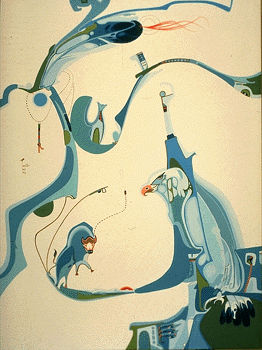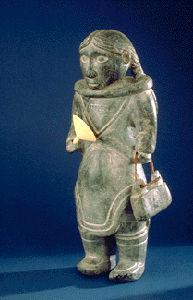Eddy “Doc” Cobiness, Ojibwe (Anishinaabe) artist (born 17 July 1933 in Warroad, Minnesota, United States; died 1 January 1996 in Winnipeg, MB). He was a founding and eminent member of Professional Native Indian Artists Inc., known widely as the Indian Group of Seven. Cobiness’s artwork was featured in many prominent collections, including those of Queen Elizabeth II, former Canadian prime minister Jean Chrétien and Academy Award-winning actor Charlton Heston. Influenced by Pablo Picasso, Cobiness worked in many mediums, including ink, watercolour, oil and acrylic, and his stylized brush strokes were referred to as “flowing.” Cobiness’s artwork often depicted animals and the natural world.

Early Life and Education
Eddy Cobiness expressed an interest as well as a skill in creating art at an early age. He was said to have used a variety of mediums readily available to him, including drawing in sand, snow and on cardboard in his childhood.
Cobiness was not formally educated in visual arts. He was mostly self-taught, studying colour and composition in painting. In the 1950s, Cobiness joined the US Army, at which time he discovered watercolour painting.
Cobiness moved to Canada and lived on Buffalo Point First Nation. While there, he kept a studio on the shore of Lake of the Woods. In 1974, Cobiness moved to Winnipeg, Manitoba. ( See also First Nations in Canada and First Nations in Manitoba.)
Career Highlights
In the 1960s, Eddy Cobiness was working in ink and watercolour, and launched a commercially successful art career. He then began working in other mediums and styles, including abstract art, and became internationally celebrated. Cobiness’s paintings were collected by Queen Elizabeth II amongst other notable figures.
In 1972, Cobiness founded Professional Native Indian Artists Inc., also known as the Indian Group of Seven, along with artists Daphne Odjig , Alex Janvier, Norval Morrisseau, Jackson Beardy , Joseph Sanchez and Carl Ray. In 1975, the group officially incorporated. Although other artists were invited to participate in the group, it was these seven artists who travelled to Winnipeg to form the historic collective.
Cobiness found work as a graphic designer before eventually becoming a celebrated contemporary First Nations artist. He later went on to teach art students. (See also Contemporary Indigenous Art in Canada .)
Cobiness was inspired by the Ojibwe (Anishinaabe ) artist Benjamin Chee Chee . With Chee Chee’s influence, Cobiness began to experiment with more abstract, stylized work, a marked shift from his early realistic painting. In 1992, Cobiness was interviewed by David Hickey for Windspeaker and divulged that he was influenced by the artist Pablo Picasso, further accounting for Cobiness’s evolving style.
Did You Know?
Eddy Cobiness was nicknamed “Doc” for his natural tendency to look after First Nations artists around him.
Activism
Later in his career, Eddy Cobiness began to sign his works with his treaty number, 47. The number appeared alongside his signature and the date. The act of signing with a treaty number was an act of protest against the Canadian government’s attempt to assimilate Indigenous peoples. Other Indigenous artists, including Alex Janvier, also signed their work with a treaty number. Cobiness used his art as a platform to draw attention to the oppression First Nations peoples endured under the Canadian government. (See also Racial Segregation of Indigenous Peoples in Canada.)
Personal Life and Death
Eddy Cobiness was married to his wife, Helen, for 34 years and had eight children. He suffered from diabetes before his death in 1996 at the age of 62.
Significance and Legacy
Eddy Cobiness and his art helped bring First Nations art to the forefront of the Canadian and international art worlds. Cobiness commented on his desire to encourage Indigenous art and artists: “I have met and worked with many talented young artists, who have so much to contribute to the world of visual art. I hope, by setting a good example myself, that someday you will get to know them too.” His work and legacy continue to create spaces for First Nations artists. Cobiness’s innovative paintings and seminal style are highly regarded today and continue to be sought after by collectors.

 Share on Facebook
Share on Facebook Share on X
Share on X Share by Email
Share by Email Share on Google Classroom
Share on Google Classroom











